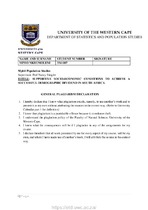| dc.description.abstract | One of the population structures associated with demographic dividend is “demographic transition”, which is a shift from high fertility and mortality to low fertility and mortality. It is understood that low dependency ratio (shows that there are relatively more adults of working age who can support the young and the old of the populace) is one major factor in achieving a successful demographic dividend (DD) (Esther, 2013). DD refers to the fast-economic growth that is achieved by a country when there are dependency ratios. This definition means that the proportion of people of working age group (15-64) is higher, compared to those of ages lower than 15 and above 64 years (Statistics SA, 2017). In addition, having a large proportion of working age people does not necessarily guarantee a successful demographic dividend. There are certain conditions to support a successful DD. According to Dewald Van Rensburg, 2017, South Africa is almost done with the achievement of demographic transition. These does not guarantee a successful demographic dividend. This study will therefore look at socio-economic conditions in support of a demographic dividend, because most of the working age people are still not employed, therefore are not productive enough to contribute to the economic growth. Socio economic conditions include (favorable labor market, economic growth, good governance, education and training, health care, family planning and gender equity) (StatsSA, 2017). These conditions if well-established will lead to a reduction of unemployment and therefore result in more labor resources becoming available to devote to production. Since many people entering working age find it difficult to get employment. Statistics South Africa shows that 38.2% of youth were unemployed in the first quarter of 2018 (Statistic South Africa, 2018), this study will have a close look at South African youth unemployment in relation to the demographic characteristics such as gender, population group, marital status, geography type and province of residence. | en_US |

